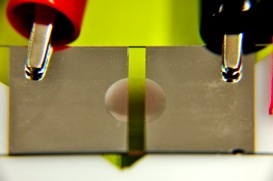








The purpose of this website is to summarize my research experience at Kansas State University during the summer of 2011.
My project was to study the behavior of gold nanoparticle solutions subject to a uniform electric field. A gold nanoparticle is a cluster of gold atoms metallically bonded together. As their name suggests, a nanoparticle in on the length scale of 10-9 meters. To imagine something so small, divide the diameter of a strand of hair by 50 and then by 1000 - this is the nanoscale. Nanoparticles have many useful and unique properties, for example: attaching themselves to cancer cells to help remove tumors, killing bacteria in clothing fabric, and even strengthening tennis rackets by filling in gaps between carbon fibers.
When placed in an electric field, solutions of gold nanoparticles appear to “pulse,” and are then attracted to the opposite direction of the electric field lines. I spent the first half of the REU program attempting to qualitatively analyze these effects. The majority of my experiments took place on a microscope slide coated with aluminum strips. The aluminum strips were used as electrodes, with which I could generate the electric field. This first half of my project ended after I was able to produce a series of short videos that showed the two effects described above.
The second half of this program was dedicated to finding a quantitative method to describe the observed effects. With much appreciated input from the N.I.R.T. group members and my project supervisor, Dr. Sorensen, I chose to focus on the initial pulse of the nanoparticles. To analyze the pulse, I measured the contact angle before and after a drop of nanoparticle solution was placed in the electric field. The contact angle is the angle formed between a drop of the nanoparticle solution and the glass surface on which it rests. In order to prep the glass surfaces for good contact angle measurements, Sean McBride guided me through his silane coating procedure that he developed through his research. After completing my experiments, I was able to produce graphs showing contact angle as a function of voltage for a 1 microliter drop of nanoparticle solution.









